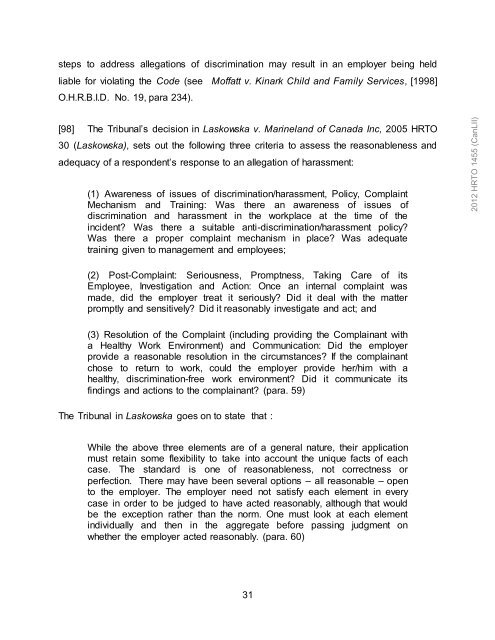FAQ's Cases - Stewart McKelvey
FAQ's Cases - Stewart McKelvey
FAQ's Cases - Stewart McKelvey
- No tags were found...
Create successful ePaper yourself
Turn your PDF publications into a flip-book with our unique Google optimized e-Paper software.
steps to address allegations of discrimination may result in an employer being heldliable for violating the Code (see Moffatt v. Kinark Child and Family Services, [1998]O.H.R.B.I.D. No. 19, para 234).[98] The Tribunal’s decision in Laskowska v. Marineland of Canada Inc, 2005 HRTO30 (Laskowska), sets out the following three criteria to assess the reasonableness andadequacy of a respondent’s response to an allegation of harassment:(1) Awareness of issues of discrimination/harassment, Policy, ComplaintMechanism and Training: Was there an awareness of issues ofdiscrimination and harassment in the workplace at the time of theincident? Was there a suitable anti-discrimination/harassment policy?Was there a proper complaint mechanism in place? Was adequatetraining given to management and employees;2012 HRTO 1455 (CanLII)(2) Post-Complaint: Seriousness, Promptness, Taking Care of itsEmployee, Investigation and Action: Once an internal complaint wasmade, did the employer treat it seriously? Did it deal with the matterpromptly and sensitively? Did it reasonably investigate and act; and(3) Resolution of the Complaint (including providing the Complainant witha Healthy Work Environment) and Communication: Did the employerprovide a reasonable resolution in the circumstances? If the complainantchose to return to work, could the employer provide her/him with ahealthy, discrimination-free work environment? Did it communicate itsfindings and actions to the complainant? (para. 59)The Tribunal in Laskowska goes on to state that :While the above three elements are of a general nature, their applicationmust retain some flexibility to take into account the unique facts of eachcase. The standard is one of reasonableness, not correctness orperfection. There may have been several options – all reasonable – opento the employer. The employer need not satisfy each element in everycase in order to be judged to have acted reasonably, although that wouldbe the exception rather than the norm. One must look at each elementindividually and then in the aggregate before passing judgment onwhether the employer acted reasonably. (para. 60)31
















